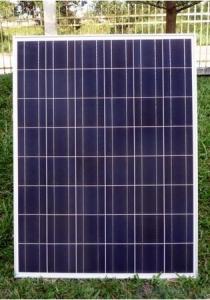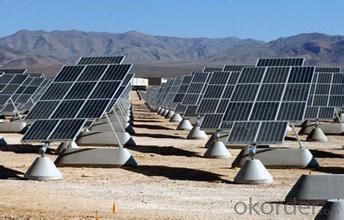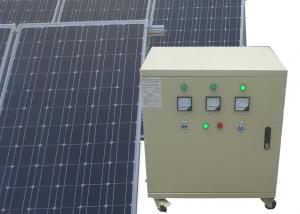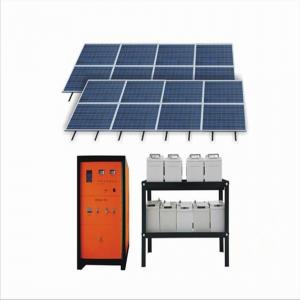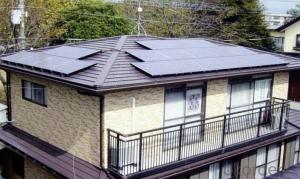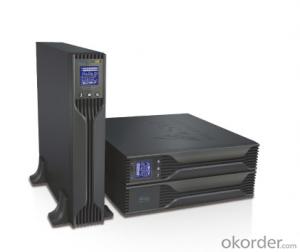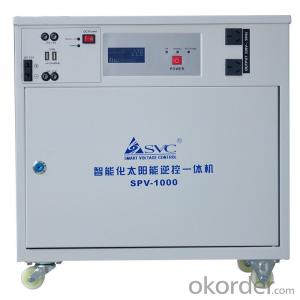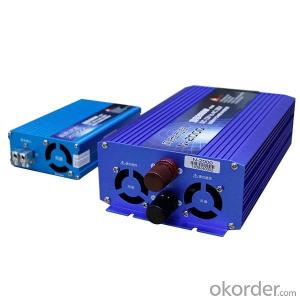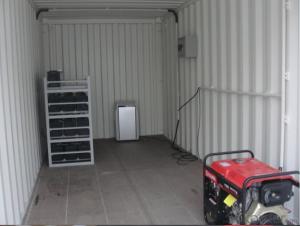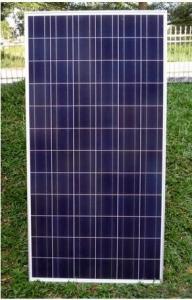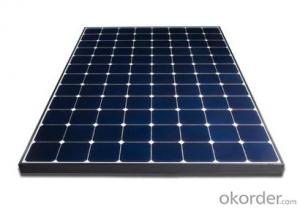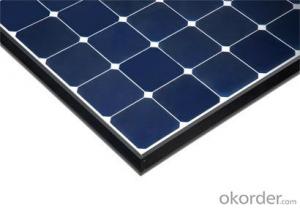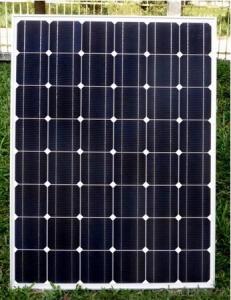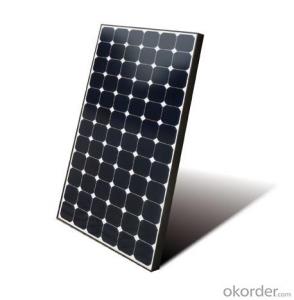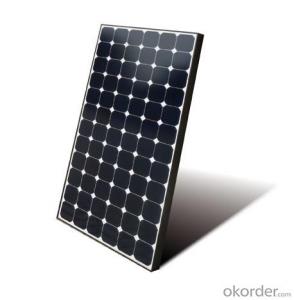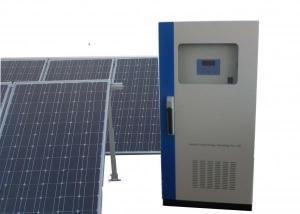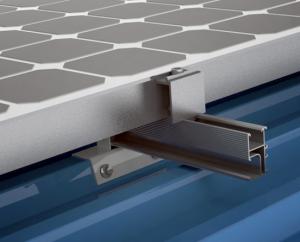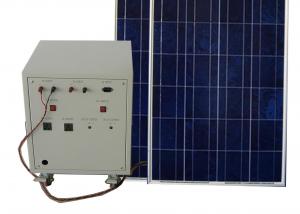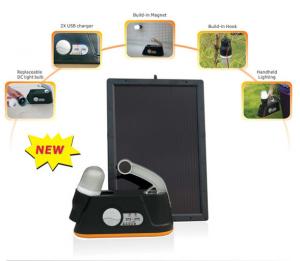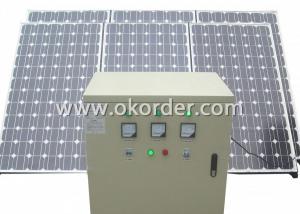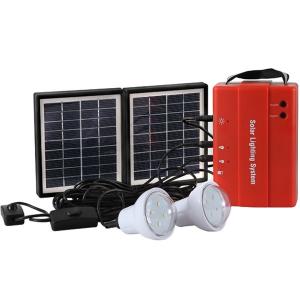Solar Energy Systems Blaine CNBM On Grid System 20000W with Certificate UL TUV CE
- Loading Port:
- Shanghai
- Payment Terms:
- TT OR LC
- Min Order Qty:
- 1000 watt
- Supply Capability:
- 1000 watt/month
OKorder Service Pledge
OKorder Financial Service
You Might Also Like
Specification
CNBM On Grid System 20000W with Certificate UL TUV CE
Product description
They range from small residential and commercial rooftop systems to large utility-scale solar power stations. Unlike stand-alone power systems, a grid-connected system rarely includes an integrated battery solution, as they are still very expensive. When conditions are right, the grid-connected PV system supplies the excess power, beyond consumption by the connected load, to the utility grid.
Connection of the photovoltaic power system can be done only through an interconnection agreement between the consumer and the utility company. The agreement details the various safety standards to be followed during the connection.[4]
A photovoltaic (in short PV) module is a packaged, connected assembly of typically 6×10 solar cells. Solar Photovoltaic panels constitute the solar array of a photovoltaic system that generates and supplies solar electricity in commercial and residential applications. Each module is rated by its DC output power under standard test conditions, and typically ranges from 100 to 365 watts. The efficiency of a module determines the area of a module given the same rated output – an 8% efficient 230 watt module will have twice the area of a 16% efficient 230 watt module. There are a few commercially available solar panels available that exceed 22% efficiency[1] and reportedly also exceeding 24%.[2][3] A single solar module can produce only a limited amount of power; most installations contain multiple modules. A photovoltaic system typically includes a panel or an array of solar modules, a solar inverter, and sometimes a battery and/or solar tracker and interconnection wiring.
The price of solar power, together with batteries for storage, has continued to fall so that in many countries it is cheaper than ordinary fossil fuel electricity from the grid (there is "grid parity").[4]
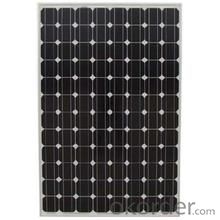
Application
Industrial
Commercial
Residential
Feature
Residential, grid-connected rooftop systems which have a capacity more than 10 kilowatts can meet the load of most consumers.[2] They can feed excess power to the grid where it is consumed by other users. The feedback is done through a meter to monitor power transferred. Photovoltaic wattage may be less than average consumption, in which case the consumer will continue to purchase grid energy, but a lesser amount than previously. If photovoltaic wattage substantially exceeds average consumption, the energy produced by the panels will be much in excess of the demand. In this case, the excess power can yield revenue by selling it to the grid. Depending on their agreement with their local grid energy company, the consumer only needs to pay the cost of electricity consumed less the value of electricity generated. This will be a negative number if more electricity is generated than consumed.[3] Additionally, in some cases, cash incentives are paid from the grid operator to the consumer.
Packaging
With carton and box
- Q: Can solar energy systems be used in residential buildings?
- Yes, solar energy systems can be used in residential buildings. In fact, many homeowners are increasingly adopting solar panels to generate electricity for their homes. These systems can be installed on rooftops or in open areas around the building, harnessing the sun's energy to power various household appliances and reduce dependence on traditional grid electricity. Additionally, solar energy systems provide a sustainable and environmentally friendly alternative, helping to reduce carbon emissions and lower electricity bills in the long run.
- Q: Can a solar energy system be installed on a floating platform?
- Yes, a solar energy system can be installed on a floating platform. In fact, floating solar power plants, also known as floating photovoltaic (FPV) systems, are gaining popularity as an innovative solution to maximize the use of water bodies for solar energy generation. These platforms are typically constructed using buoyant materials such as plastic or concrete, which allow the solar panels to float on the water's surface. There are several advantages to installing solar panels on floating platforms. Firstly, it allows for the utilization of underutilized water bodies such as reservoirs, dams, and ponds, thereby optimizing land use. Secondly, the water beneath the solar panels helps to cool them down, which can increase their efficiency and overall energy output. Additionally, the floating platforms can reduce evaporation from the water surface, thereby conserving water resources. Floating solar energy systems also have environmental benefits. By utilizing water bodies for solar energy generation, these systems reduce the need to clear land for large-scale solar installations, preserving ecosystems and biodiversity. Furthermore, they can help reduce algae growth and improve water quality by shading the water surface and reducing sunlight penetration. While floating solar systems present unique engineering challenges, such as anchoring and stability, advancements in technology have made them increasingly feasible and cost-effective. Several countries, including Japan, China, and the Netherlands, have successfully implemented floating solar power plants, showcasing their potential as a sustainable energy solution. In summary, a solar energy system can indeed be installed on a floating platform. These floating photovoltaic systems offer numerous benefits, including optimized land use, increased energy efficiency, water conservation, and environmental preservation. As technology continues to advance, we can expect to see more floating solar power plants being deployed worldwide.
- Q: Can solar energy systems be used in areas with limited access to solar energy conferences and expos?
- Yes, solar energy systems can be used in areas with limited access to solar energy conferences and expos. While conferences and expos provide valuable information and networking opportunities, they are not essential for the installation and functioning of solar energy systems. Technicians and experts can still design and install solar systems based on site assessments and available resources. Additionally, there are online resources and virtual conferences that can help disseminate knowledge and provide updates on the latest advancements in solar energy technology.
- Q: Can solar energy systems be used to power homes?
- Yes, solar energy systems can be used to power homes. Solar panels capture sunlight and convert it into electricity, which can then be used to power various appliances and systems within a home. This sustainable and renewable energy source can provide a reliable and cost-effective alternative to traditional utility electricity.
- Q: Can solar energy systems be used in agricultural applications?
- Yes, solar energy systems can be used in agricultural applications. They can power irrigation systems, provide electricity for remote farms, run livestock operations, and support various other farming activities. Solar panels can be installed on rooftops, on the ground, or integrated into agricultural structures like greenhouses, providing a sustainable and reliable source of energy for the agricultural sector.
- Q: How does the efficiency of solar panels vary across different installation angles?
- The efficiency of solar panels can vary across different installation angles due to several factors. The angle at which solar panels are installed determines the amount of sunlight they receive and how effectively they can convert it into electricity. Ideally, solar panels should be installed at an angle that allows them to capture the maximum amount of sunlight throughout the day. This angle is usually determined by the latitude of the installation site. For example, in locations closer to the equator, a lower tilt angle is preferred, while higher latitudes require a steeper tilt angle. If the installation angle is too low, the solar panels may not receive enough sunlight, especially during the winter months when the sun is lower in the sky. On the other hand, if the angle is too steep, sunlight may be reflected off the surface of the panels instead of being absorbed, resulting in a decrease in efficiency. Additionally, the efficiency of solar panels can also be influenced by the orientation of the installation angle. In the northern hemisphere, solar panels facing south tend to receive the most sunlight throughout the day. However, east or west-facing panels can also be effective, especially if there is a need to optimize energy production during specific times of the day. Furthermore, the efficiency of solar panels can be affected by shading. Obstructions such as trees, buildings, or other structures can cast shadows on the panels, reducing their overall efficiency. Therefore, it is essential to consider the potential shading impacts when determining the installation angle. In conclusion, the efficiency of solar panels varies across different installation angles primarily due to the amount of sunlight they receive and how effectively they can convert it into electricity. It is crucial to find the optimal installation angle and orientation to maximize energy production and overall efficiency.
- Q: Can solar energy systems be used in areas with limited access to financing options?
- Yes, solar energy systems can be used in areas with limited access to financing options. There are various alternative financing options available such as leasing, power purchase agreements, and community funding that make solar energy more accessible to people in areas with limited financing options. Additionally, government incentives and subsidies can also help reduce the financial burden of installing solar energy systems in such areas.
- Q: Can solar energy systems be used in powering retirement homes or assisted living facilities?
- Retirement homes and assisted living facilities can indeed utilize solar energy systems to power their operations. These facilities face a substantial energy demand for heating, cooling, lighting, and electrical appliances. However, by installing solar panels on rooftops or suitable areas, these facilities can generate their own electricity and decrease their dependence on the grid. The implementation of solar energy systems offers significant advantages for these establishments. One notable benefit is the potential for substantial cost reduction, as solar power can offset a significant portion of their electricity bills. This aspect is especially crucial for retirement homes and assisted living facilities, which operate on limited budgets and must allocate resources efficiently. By harnessing solar power, these facilities can redirect the saved funds toward providing enhanced care and services for their residents. Moreover, solar energy systems contribute to a cleaner and more sustainable environment. Retirement homes and assisted living facilities bear a responsibility to promote their residents' well-being, and the utilization of solar power enables them to reduce their carbon footprint. This environmentally friendly approach can positively impact the health and overall quality of life for the residents. Additionally, solar energy systems serve as a reliable power source during emergencies or power outages. In areas prone to extreme weather events, where power disruptions are frequent, having a solar energy system with battery storage ensures a continuous and uninterrupted power supply to critical areas such as medical equipment, lighting, and HVAC systems. In conclusion, solar energy systems offer a feasible and advantageous solution for powering retirement homes and assisted living facilities. These systems can significantly decrease operating costs, promote sustainability, and provide a reliable power source, ultimately enhancing the quality of care and services provided to residents.
- Q: How do solar energy systems impact the transportation sector?
- Solar energy systems can have a significant impact on the transportation sector by reducing reliance on fossil fuels. Solar-powered electric vehicles (EVs) offer a sustainable and renewable alternative to traditional gasoline-powered cars, reducing greenhouse gas emissions and air pollution. Additionally, solar energy can be used to power charging stations for EVs, making them more accessible and convenient for users. This shift toward solar energy in transportation promotes a cleaner and more sustainable future.
- Q: How do solar energy systems impact the overall sustainability of a home?
- Solar energy systems have a significant impact on the overall sustainability of a home. Firstly, they greatly reduce dependence on fossil fuels, which are finite and contribute to climate change. By harnessing the power of the sun, solar energy systems generate clean, renewable electricity that doesn't produce harmful emissions or pollutants. This not only helps to mitigate climate change but also improves air quality in the surrounding environment. Furthermore, solar energy systems provide homeowners with energy independence and resilience. By generating their own electricity, homeowners can reduce their reliance on the grid and avoid the volatility of energy prices. This can lead to long-term cost savings and greater financial stability. Additionally, during power outages or natural disasters, solar energy systems with battery storage can provide a reliable source of electricity, ensuring essential appliances and systems keep running. Solar energy systems also increase the energy efficiency of a home. By supplementing or replacing traditional energy sources, these systems reduce the overall energy consumption of a household. This, in turn, lowers utility bills and conserves resources. Moreover, the installation of solar panels can increase the value of a home. As renewable energy becomes more popular and desirable, potential homebuyers are increasingly willing to pay a premium for properties with solar energy systems. This not only benefits homeowners who are looking to sell their homes but also contributes to the overall growth and adoption of sustainable energy solutions. Lastly, solar energy systems promote a sense of environmental stewardship and sustainability. By utilizing renewable energy, homeowners can actively contribute to reducing their carbon footprint and preserving the planet for future generations. This commitment to sustainability extends beyond the household, inspiring others to embrace clean energy and work towards a greener future. In conclusion, solar energy systems have a positive and far-reaching impact on the overall sustainability of a home. They reduce dependence on fossil fuels, increase energy efficiency, provide energy independence and resilience, boost property value, and promote environmental stewardship. By harnessing the power of the sun, solar energy systems pave the way for a more sustainable and resilient future.
Send your message to us
Solar Energy Systems Blaine CNBM On Grid System 20000W with Certificate UL TUV CE
- Loading Port:
- Shanghai
- Payment Terms:
- TT OR LC
- Min Order Qty:
- 1000 watt
- Supply Capability:
- 1000 watt/month
OKorder Service Pledge
OKorder Financial Service
Similar products
Hot products
Hot Searches
Related keywords
